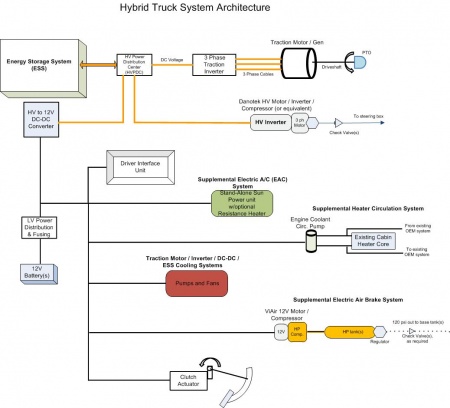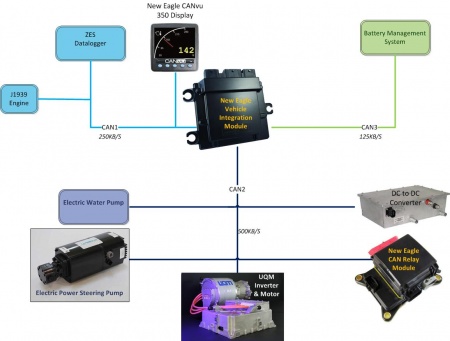Hybrid Truck System
Opportunity

Develop an aftermarket Class 8 truck electric vehicle / hybrid electric vehicle system with Zero Emission Systems to:
- Provide the electronic controls, control algorithm and system integration.
- Operate in electric vehicle mode when in port to provide zero emissions while queuing.
- Operate in hybrid electric vehicle mode during normal operation to provide better fuel economy.
- Integrate the system on a vehicle to provide prototype demonstration of the benefits.
- Support vehicle performance testing.
Solution
New Eagle provided the vehicle integration module, the controller area network (CAN) relay box, HMI display and the vehicle integration module algorithm and software for an aftermarket EV/HEV system. We also provided extensive onsite vehicle support and system integration and verification.
Hardware
New Eagle selected the ECM-5554-112-0904 calibratable electronic control module for the vehicle integration module (VIM) and the Multiplexed Power Distribution Module (MPDM) for the CAN relay controller. The VIM interfaced with all of the components in the system through three independent CAN channels. In addition, the VIM read sensors such as pressure and steering position, and controled outputs such as the electric power steering input control and the various system relays. New Eagle used an electric vehicle test bench to test the CAN interfaces of the components prior to vehicle integration.

A CANvu 350 module was selected as the prototype display unit for the system. For future upgrades this display will be replaced by the more powerful and more cost effective VeeCAN 320 display.
Toolchain
The MotoHawk and New Eagle toolchain was employed to acclerate development. Using the Matlab / Simulink environment, the team was able to unit test and integrate the model in the simulation environment in parallel to the mechanical hardware development. The early start on algorithm development saved several weeks off of the timeline. New Eagle also utilized the Network Toolbox to quickly implement the CAN messaging strategy.Many of the actuators and sensors had defined DBC files for the CAN control commands and output feedback. By using the Network Toolbox, the messaging strategy was quickly implemented allowing more time for the critical algorithm development.
Control Algorithm
New Eagle has extensive experience developing controls and algorithms for EV and HEV Systems. The Matlab / Simulink controls libraries were implemented with modifications for the specific components in the ZES system. Using the proven control libraries allowed rapid deployment of the system while also increasing confidence by using verified software components.
Results
With New Eagle's help, Zero Emissions Systems was able to successfully demonstrate the operation of the EV/HEV system on a vehicle. The system was shown to:
- Provide electric vehicle (EV) operation while in port for up to 2-3 hours and at speeds up to 20mph.
- Supply auxiliary systems for up to 10 hours through the electrical system.
- Run in hybrid electric vehicle mode through the PTO during normal operation.
- Improve fuel economy by up to 25%.
- Charge through the engine and regenerative braking.
- Provide high voltage operation from 403 volts to 550 volts.
- Implement a J1939 compatible CAN 2.0 link.
- Provide a 1-1½ year return on investment in fuel savings.
